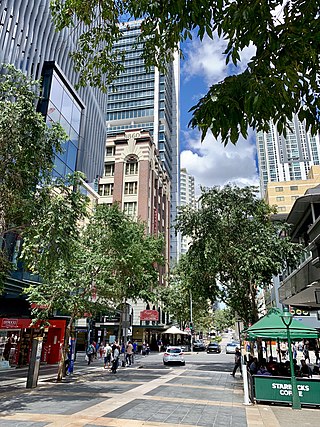
Milton is a riverside inner suburb of the City of Brisbane, Queensland, Australia. In the 2021 census, Milton had a population of 3,144 people.

Central railway station is located on the North Coast line in Queensland, Australia. It is the principal station on the City network and is located in the north of the Brisbane central business district. Central station is one of four inner city stations that form a core corridor through the centre of Brisbane.

Kangaroo Point is an inner southern suburb in the City of Brisbane, Queensland, Australia. In the 2021 census, Kangaroo Point had a population of 9,689 people.

The South Bank Parklands are located at South Bank within the suburb of South Brisbane in Brisbane, Queensland, Australia. The parkland, on the transformed site of Brisbane's World Expo 88, was officially opened to the public on 20 June 1992.

South Brisbane is an inner southern suburb in the City of Brisbane, Queensland, Australia. In the 2021 census, South Brisbane had a population of 14,292 people.

Caloundra is a coastal town in the Sunshine Coast Region, Queensland, Australia.

Wickham Park is a park at 330 Wickham Terrace, Spring Hill, Brisbane, Queensland, Australia.

Brisbane City is the central suburb and central business district of Brisbane, the state capital of Queensland, Australia. It is also colloquially referred to as the "Brisbane CBD", "the city", or simply "town". The CBD is located on a point on the northern bank of the Brisbane River, historically known as Meanjin, Mianjin or Meeanjin in the local Yuggera dialect. The triangular-shaped peninsula is bounded by the median of the Brisbane River to the east, south and west. The point, known at its tip as Gardens Point, slopes upward to the north-west where the city is bounded by parkland and the inner city suburb of Spring Hill to the north. The CBD is bounded to the north-east by the suburb of Fortitude Valley. To the west the CBD is bounded by Milton, Petrie Terrace, and Kelvin Grove.

Petrie Terrace is an inner suburb in the City of Brisbane, Queensland, Australia. In the 2021 census, Petrie Terrace had a population of 1,168 people.

Spring Hill is an inner northern suburb in the City of Brisbane, Queensland, Australia. In the 2021 census, Spring Hill had a population of 6,593 people.

George Street is a major street located in the Brisbane CBD in Brisbane, Queensland, Australia.

Hamilton is an affluent riverside mixed-use suburb in the north-east of the City of Brisbane, Queensland, Australia. Hamilton is located along the north bank of the Brisbane River. In the 2021 census, Hamilton had a population of 8,922 people.

Albert Street is a street in the Brisbane central business district, Queensland, Australia. It was named after Prince Albert, the Prince Consort of Queen Victoria of the United Kingdom. Albert Street railway station is being built directly beneath the street and is expected to open in 2026. The station precinct includes partial road closures as planned in the 2014 City Centre Master Plan, for the creation of a new public space.

Ram Vanji Sutar is an Indian sculptor. He designed the Statue of Unity which is the world's tallest statue with a height of 182 metres, exceeding the Spring Temple Buddha by 54 metres.

Lady Bowen Hospital is a heritage-listed former maternity hospital and now social housing and office complex at 497–535 Wickham Terrace, Spring Hill, City of Brisbane, Queensland, Australia. It was designed by John H. Buckeridge and built from 1889 to 1890 by John Quinn. It was also known as Brisbane Lying-In Hospital and the Lady Bowen Hostel. It was added to the Queensland Heritage Register on 23 April 1999. The complex consists of the former hospital and nurses' quarters buildings; a third building which had been contained in the heritage listing was demolished c. 2005–2008.

Wickham Terrace is one of the historic streets of Brisbane, Queensland, Australia. It is known as the street of private medical specialists.

Gregory Terrace is a road in Brisbane, Queensland, Australia.

Jacob's Ladder is a landmark in Brisbane, Queensland, Australia. It is a long pedestrian staircase that extends from Edward and Turbot Streets up to Wickham Terrace. The name is a reference to the Biblical stairway ascending to Heaven. Jacob's Ladder has 86 steps.

Roma Street is a major street in Brisbane, the capital of Queensland, Australia. It is named after Diamantina Bowen, the wife of the first Governor of Queensland, George Bowen.
Turbot Street runs parallel to Ann Street and is on the northern side of the Brisbane CBD in Queensland, Australia. It is a major thoroughfare, linking as a three-to-five lane one-way street with the Riverside Expressway in the southwest to the suburb of Fortitude Valley in the northeast; address numbers run the same direction. It is a one-way pair with Ann Street.
































